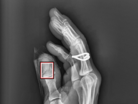5 minutes with Mads Jarner Brevadt, CEO of Radiobotics

Hello Mads, please introduce yourself and your role.
“I’m Mads Jarner Brevadt – co-founder and CEO of Radiobotics.”
What is Radiobotics’ RBfractureTM?
“RBfractureTM is a medical grade software tool that can be integrated into a hospital's IT-system, and detect a fracture in X-rays of bones and joints, assisting clinical staff and minimising the risk of missing fractures.”
How can AI-powered products support healthcare?
“AI-powered products can be an assistive support tool that works as an extra pair of eyes for healthcare professionals, ensuring higher accuracy and streamlining tedious tasks such as reading high volumes of X-rays. AI-tools are especially good for specific repetitive tasks such as recognising very specific patterns in images. In general, the demand for X-rays is increasing while there is a global shortage of radiologists and AI-powered products can help ease this burden in the healthcare system.”
Tell us about the class IIa medical device certification.
“With the new Medical Device Regulation (MDR) in Europe, decision support software like ours needs to be classified as class IIa, that requires a thorough audit from a Notified Body. We have gone through this scrutiny, ensuring that we have a safe device that can be put on the market, living up to the latest and appropriate standards for software-as-a-medical-device.”
How can your medical devices assist in missed fracture cases?
“The purpose is exactly to act as a decision support tool or essentially being a second pair of eyes, giving an extra layer of certainty in detecting features when they are present or see if they are not, aiming to reduce errors, including missed fractures, that can cause additional cost to the hospitals and be burdensome for the patient as well.”
Has there been any resistance among colleagues or patients for using AI in this way?
“At this point we have received a lot of positive feedback, since we are essentially assisting and ensuring that the readers of the X-ray has certainty in their findings which also benefits the patients.”
How can RBfractureTM reduce errors, minimise costs, reduce time and improve the treatment of patients?
“RBfractureTM will run an analysis on a set of X-rays after this has been acquired in the emergency room. Our software will provide a second opinion if there are one or more fractures in the image and where to locate them. This is fully integrated into the hospital’s IT system and it has the potential to reduce cases with missed fractures, since staff with only a few years of experience in reading X-rays can be challenged if the fracture is not obvious. Being able to provide a reading by RBfractureTM instantly, can reduce the time it takes to get a read and thereby also reduce time from taking the image to making a decision on where to triage the patient next. Additionally, reducing missed fracture cases can also mean a reduction in unnecessary imaging and shorter waiting times for patients.”
During your time at RBfractureTM, what has been your biggest lesson?
“To build a comprehensive product like RBfractureTM requires a lot of specific clinical insight into different protocols, types of fractures and a lot of data and annotations to be able to make an algorithm with high precision. That is why we found the ideal partner to develop this with; vRad, a leading teleradiology practice, that has provided some of this insight, together with access to a high volume of images with the appropriate diversity in the dataset, ensuring that the product can work globally.”
What do the next 12 months hold for you and the company?
“We will focus on getting RBfractureTM to as many hospitals as possible, to create the value it is designed for, together with expanding our product portfolio and offerings, being able to cover more disease areas besides fractures.”
- Schneider Electric's Commitment to Sustainable ManufacturingSustainability & ESG
- Lenovo & Saudi Alat Building Green Manufacturing FacilitySustainability & ESG
- Nissan Brings Biodiversity to the Factory through RewildingSustainability & ESG
- Capgemini: Gen AI Cause of Spiking Semiconductor DemandAI & Automation


